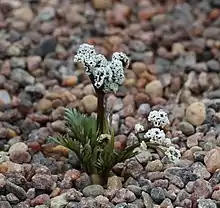Lomatium gormanii
Lomatium gormanii, with the common names Gorman's biscuitroot and salt & pepper,[1] is a perennial herb of the family Apiaceae.[2] It is endemic to the Northwestern United States, in Idaho, Oregon, and Washington,[2] being found in steppes and montane environments.[1] It is called sasamít̓a, sasamít̓aya, and łałamít̓a in the Sahaptin language.
| Lomatium gormanii | |
|---|---|
 | |
| Scientific classification | |
| Kingdom: | Plantae |
| Clade: | Tracheophytes |
| Clade: | Angiosperms |
| Clade: | Eudicots |
| Clade: | Asterids |
| Order: | Apiales |
| Family: | Apiaceae |
| Genus: | Lomatium |
| Species: | L. gormanii |
| Binomial name | |
| Lomatium gormanii (Howell) J.M.Coult. & Rose | |
The species flowers before many in the sagebrush steppe, when the ground is still covered in snow.[1] Its condimental common name refers to the darkness of the violet anthers and the white petals.[1] The leaves are divided and narrow.[1]
Lomatium gormanii is easily confused with Lomatium piperi (Sahaptin mámɨn), but the roots are generally larger and 'hairier' (i.e., many more rootlets) than L. piperi, and it appears to grow where that species does not.[3]
References
- Taylor, Ronald J. (1994) [1992]. Sagebrush Country: A Wildflower Sanctuary (rev. ed.). Missoula, MT: Mountain Press Pub. Co. p. 94. ISBN 0-87842-280-3. OCLC 25708726.
- USDA, NRCS (n.d.). "Lomatium gormanii". The PLANTS Database (plants.usda.gov). Greensboro, North Carolina: National Plant Data Team. Retrieved 23 June 2015.
- Personal communication from botanist Dave Corliss